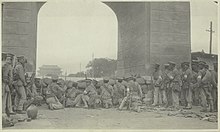
Back استعادة المانشو Arabic Restauración manchú Spanish Restauration mandchoue de 1917 French Mandzsu restauráció Hungarian Restorasi Manchu ID Restaurazione Manciù Italian 張勲復辟 Japanese 장훈복벽 Korean Restauração Manchu Portuguese Попытка реставрации династии Цин Russian
| Manchu Restoration | |||||||
|---|---|---|---|---|---|---|---|
| Part of the Warlord Era | |||||||
 Republican troops fighting to retake the Forbidden City on July 12, 1917, after Zhang Xun’s attempted imperial restoration | |||||||
| |||||||
| Belligerents | |||||||
|
| |||||||
| Commanders and leaders | |||||||
|
|
| ||||||
The Manchu Restoration or Dingsi Restoration[2] (Chinese: 丁巳復辟), also known as Zhang Xun Restoration[3] (simplified Chinese: 张勋复辟; traditional Chinese: 張勳復辟), or Xuantong Restoration[4] (simplified Chinese: 宣统复辟; traditional Chinese: 宣統復辟), was an attempt to restore the Chinese monarchy by General Zhang Xun, whose army seized Beijing and briefly reinstalled the last emperor of the Qing dynasty, Puyi, to the throne. The restoration lasted just less than two weeks, from July 1 to July 12, 1917,[5] and was quickly reversed by Republican troops. Despite the uprising's popular name ("Manchu Restoration"), almost all putschists were ethnic Han.[1]
- ^ a b Rhoads (2000), p. 243.
- ^ Shin'ichi Yamamuro (February 8, 2006). Manchuria Under Japanese Dominion. University of Pennsylvania Press. pp. 322–. ISBN 978-0-8122-3912-6.
- ^ Modern Chinese History Dictionary. History of Chinese Communist Party Publishing House. 1992. ISBN 978-7-80023-476-7.
- ^ Shih Yuan. Institute of History of National Taiwan University. 1984.
- ^ Literary Knowledge. Henan People's Publishing House. 1984.